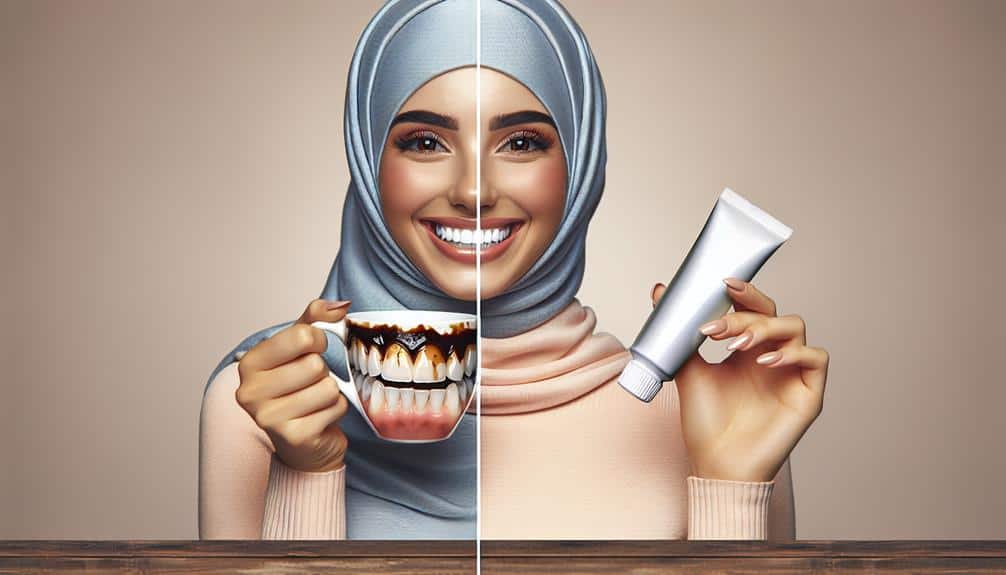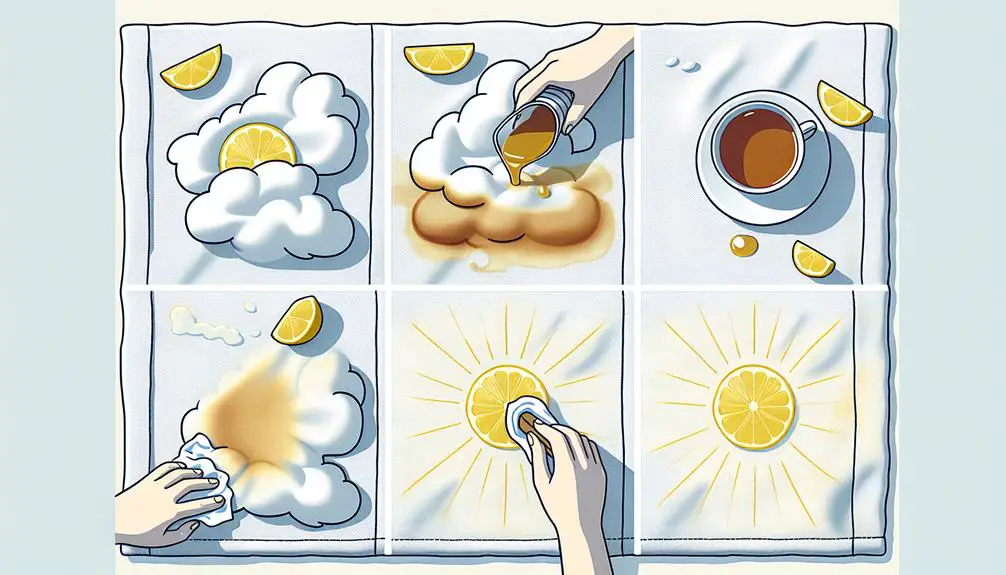To whiten teeth after tea stains, try DIY remedies like baking soda and hydrogen peroxide. Gentle cleaning techniques can help restore brightness. Consider using mouthwash with hydrogen peroxide to reduce stains. Professional whitening treatments can offer quick results, with in-office options or at-home kits available. Lifestyle changes such as limiting black tea intake and maintaining oral hygiene can prevent future staining. Regular dental check-ups aid in stain prevention. These simple steps can help you achieve a radiant smile.
Key Points
- Use natural remedies like baking soda and hydrogen peroxide for gentle whitening.
- Consider professional whitening options for quick and efficient results.
- Maintain good oral hygiene to prevent future tea stain discoloration.
- Limit intake of black tea and incorporate stain-fighting foods.
- Consult with a dentist for personalized advice on whitening treatments.
Understanding Tea Stain Discoloration
To understand tea stain discoloration, it's essential to grasp how tannins in tea interact with tooth enamel, causing the yellowing or browning effect. Tea contains tannins, which are a type of polyphenol that can adhere to the enamel surface of your teeth. When left unchecked, these tannins can lead to unsightly stains over time.
Tea stain prevention is key in maintaining a bright smile. One way to prevent tea stains is by minimizing your tea consumption or using a straw to bypass direct contact with your teeth. Additionally, practicing good oral hygiene, such as regular brushing and flossing, can help remove surface stains before they set in.
Protecting your tooth enamel is vital in combating tea stains. Enamel acts as a protective barrier for your teeth, and maintaining its health is essential in preventing discoloration. Avoiding overly acidic or sugary foods and drinks, which can weaken enamel, and using fluoride toothpaste to strengthen enamel can help safeguard against tea stains. By understanding these dynamics, you can take proactive steps to prevent and combat tea stain discoloration effectively.
Effective DIY Tea Stain Removal
For effective DIY tea stain removal, consider utilizing natural remedies and gentle cleaning techniques to restore the brightness of your teeth. Natural remedies like baking soda and hydrogen peroxide can help lift tea stains from your teeth. Create a paste by mixing a small amount of baking soda with water and gently brush your teeth with this mixture. Remember not to scrub too hard to avoid damaging your enamel.
Another option is to use hydrogen peroxide as a mouthwash after brushing your teeth. It can help reduce the appearance of stains. Additionally, incorporating tea stain prevention practices like drinking tea through a straw, rinsing your mouth with water after consuming tea, and brushing your teeth regularly can help minimize future staining.
These simple DIY methods can be effective in tackling tea stains and maintaining a brighter smile without the need for professional whitening treatments.
Professional Whitening Options Available
Professional whitening options are available to help you achieve a brighter smile by effectively removing stubborn stains caused by tea consumption. In-office treatments provided by dentists offer a quick and efficient way to whiten teeth. These procedures involve the use of professional-grade whitening agents that can noticeably lighten tea stains in a single session. Dentists can also customize the treatment based on the severity of the stains and your desired level of whitening.
Alternatively, at-home whitening kits are another option for tackling tea stains. These kits typically contain whitening gel and custom trays that mold to your teeth. While not as potent as in-office treatments, at-home kits can still produce visible results over time. It's important to follow the instructions carefully to avoid potential gum irritation or uneven whitening.
Both in-office treatments and at-home kits can help you combat tea stains effectively. Consulting with your dentist can help you determine the best option based on your budget, time constraints, and desired level of whitening.
Lifestyle Changes to Prevent Future Stains
Considering your journey towards a brighter smile free of tea stains, implementing lifestyle changes can be key in preventing future discoloration of your teeth. To start, focusing on your dietary habits is essential. Limiting the intake of tea, especially black tea which is known to cause stubborn stains, can greatly reduce the likelihood of new discoloration. Additionally, incorporating crunchy fruits and vegetables like apples and carrots into your diet can help naturally scrub away surface stains from your teeth.
Moreover, maintaining excellent oral hygiene practices is vital in preventing tea stains from reoccurring. Brushing your teeth at least twice a day with a fluoride toothpaste and flossing daily can help remove plaque buildup and prevent the accumulation of stains. Regular dental check-ups and professional cleanings can also aid in keeping your teeth free from tea-induced discoloration. By making these simple lifestyle changes, you can enjoy a radiant, stain-free smile for longer periods.
Maintenance Tips for a Lasting Bright Smile
To maintain a lasting bright smile, consistent adherence to proper oral hygiene practices is essential. Establishing a daily routine that includes brushing your teeth at least twice a day for two minutes each time, along with flossing, can help prevent stains and maintain the whiteness of your teeth. It's important to use a fluoride toothpaste and a soft-bristled toothbrush to avoid damaging the enamel while effectively removing plaque and surface stains. Additionally, incorporating mouthwash into your routine can help kill bacteria and freshen your breath.
Dietary habits play a significant role in the maintenance of a bright smile. Limiting the consumption of tea, coffee, red wine, and other stain-causing foods and beverages can prevent new stains from forming on your teeth. Drinking water after consuming these items can also help wash away pigments and reduce their staining effects. Moreover, incorporating crunchy fruits and vegetables like apples and carrots into your diet can help naturally scrub your teeth and promote saliva production, which aids in protecting your enamel. By following these maintenance tips consistently, you can enjoy a lasting bright smile.
Frequently Asked Questions
Are There Any Natural Remedies That Can Help Whiten Teeth After Tea Stains?
To naturally whiten teeth after tea stains, try using lemon juice and baking soda for their mild bleaching properties. Additionally, coconut oil and activated charcoal can help remove surface stains effectively. Remember to use these remedies in moderation for best results.
Can Using Whitening Toothpaste Alone Effectively Remove Tea Stains From Teeth?
To effectively remove tea stains from teeth, using whitening toothpaste alone may not be sufficient. Consider incorporating a baking soda technique, a hydrogen peroxide method, charcoal powder, or oil pulling for a more thorough approach to teeth whitening.
How Long Does It Typically Take for Professional Whitening Treatments to Show Noticeable Results on Tea-Stained Teeth?
Whitening gels are known for their incredible effectiveness. Professional treatments typically yield noticeable results on tea-stained teeth in just a few sessions. Home remedies might take longer to show significant changes, but professional care offers quicker and more visible outcomes.
Are There Any Specific Foods or Drinks to Avoid to Prevent Tea Stains From Reoccurring After Whitening?
To prevent tea stains from reoccurring after whitening, it's advisable to explore tea alternatives. Stain prevention can be aided by avoiding highly pigmented beverages like tea. Opt for lighter colored drinks to maintain your bright smile.
Is It Safe to Use At-Home Whitening Kits to Maintain a Bright Smile After Removing Tea Stains?
Using at-home whitening kits post-tea stain removal can be safe and effective. Consider cost comparison and convenience. Follow product instructions for best results. Prioritize safety concerns and enjoy a bright smile.



